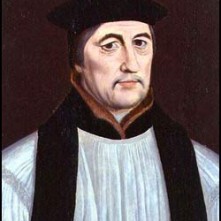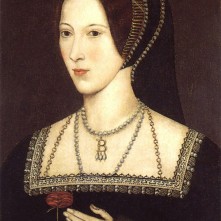21 August
1536 – Death of Robert Sherborn (Sherborne), former Bishop of Chichester, at Chichester. He was buried in the cathedral there. The elderly and conservative bishop was forced to resign his see in June 1536 after being examined by Dr Richard Layton.
1551 – Death of Sir John Packington, judge. He was buried at Hampton Lovett in Worcestershire, where he had settled in 1528. Packington was an active member of the Council of the Marches, a justice for North Wales, Recorder of Worcester, a judge on the Brecon circuit in Wales, and Recorder of Ludlow.
1553 – Death of Sir Thomas Heneage, courtier. Heneage served Henry VIII as Groom of the Stool and Chief Gentleman of the Privy Chamber, and served Edward VI as a Gentleman of the Privy Chamber. He was buried in the chancel of the parish church at Hainton, Lincolnshire.
1568 – Death of Humphrey Llwyd, antiquary, translator and cartographer from a fever. He was buried in the north aisle of St Marcella's (Llanfarchell) Church, which is also known as Whitchurch or Eglwys Wen. Llwyd is known for producing the first ever printed map of Wales.
22 August
1485 - The Battle of Bosworth. In rural Leicestershire near Market Bosworth, the armies of King Richard III and Henry Tudor faced each other in a battle that would see the death of the King and the beginning of a new dynasty: the Tudor dynasty.
1532 – Death of William Warham, Archbishop of Canterbury and administrator to Henry VIII, in Hackington, Kent. Warham served Henry VIII as Keeper of the Great Seal, and Lord Chancellor. Warham was buried in Canterbury Cathedral, having left instructions to be buried near the spot where Thomas Becket was killed.
1545 – Death of Charles Brandon, Duke of Suffolk, magnate, courtier, soldier and close friend of Henry VIII, at Guildford, while making preparations to lead an army to Boulogne. He was laid to rest in St George's Chapel, Windsor Castle.
1552 – Edward VI visited Christchurch on his royal progress.
1553 – Execution of John Dudley, Earl of Warwick and Duke of Northumberland, on Tower Hill for his part in putting his daughter-in-law, Lady Jane Grey, on the throne in place of Mary I. Click here to read more.
1572 – Execution of Thomas Percy, 7th Earl of Northumberland, in the Pavement at York. He was executed for treason after leading the Rising of the North against Elizabeth I. His body was buried in St Crux Church, York.
1583 – Death of Sir Henry Bedingfeld of Oxburgh Hall, administrator. He was buried at Oxborough parish church in Norfolk. Bedingfeld's career included him serving Edward VI and Mary I as a Privy Councillor, and Mary I as Lieutenant of the Tower of London, Captain of the Guard and Vice-Chamberlain of the Household. He was Constable of the Tower of London during the imprisonment of Mary I's half-sister, Elizabeth (the future Elizabeth I).
23 August
1524 – Death of Edmund Audley, Bishop of Salisbury, at Ramsbury. He was buried in Salisbury Cathedral, on the north side of the presbytery.
1535 – King Henry VIII and his wife, Queen Anne Boleyn, visited Sir Nicholas Poyntz at his home, Acton Court, in South Gloucestershire as part of their progress to the south-west.
1548 - Francis Talbot, 5th Earl of Shrewsbury, arrived at the Siege of Haddington, in East Lothian, Scotland, with a large army. The English troops eventually withdrew in September 1549. They had used up their supplies and suffered heavy losses from the plague, and from attacks by the Scots.
1553 – Stephen Gardiner, Bishop of Winchester, was made Lord Chancellor by Mary I.
1568 – Death of Thomas Wharton, 1st Baron Wharton, who was rewarded with a barony after his victory at the Battle of Solway Moss in 1542. He died at Healaugh, in the West Riding of Yorkshire, and was buried there.
1613 – Death of John Harington, 1st Baron Harington of Exton, courtier, from a fever at Worms. His body was sent back to England for burial at Exton. In Elizabeth I's reign, Harington served as a member of Parliament, Justice of the Peace, Sheriff and Deputy Lieutenant of Rutland and Warwickshire.
24 August
1507 – Death of Cecily, Viscountess Welles (Cecily of York), third daughter of Edward IV and Elizabeth Woodville, at Hatfield, Hertfordshire. She was buried at “the friars”, but it is not known what religious house the record was referring to.
1549 – Death of Sir Wymond Carew, administrator. Carew served Henry VIII as Deputy Receiver-General of the Duchy of Cornwall, as Receiver-General to Queens Jane Seymour and Anne of Cleves, as Treasurer to Queen Catherine Parr, and as Treasurer of the Court of First Fruits and Tenths.
1561 – Birth of Thomas Howard, 1st Earl of Suffolk, naval officer and administrator. Howard was St the eldest son of Thomas Howard, 4th Duke of Norfolk, and Margaret Dudley. Howard served Elizabeth I as Vice-Admiral in the 1596 Cadiz expedition and the 1597 voyage to the Azores, and as Constable of the Tower of London. He went on to have a distinguished career under James I until his fall in 1619.
1572 - The St Bartholmew's Day Massacre took place. An estimated 3,000 French Protestants (Huguenots) were massacred in Paris, and a further estimated 7,000 in the provinces. Click here for more information.
1587 – Death of Richard Barnes, Bishop of Durham. He was buried at Durham Cathedral, in the choir.
1595 – Death of Thomas Digges, mathematician, astronomer, soldier and member of Parliament. Digges is known as the first man to expound the Copernican system in English, and one of the first to put forward the idea of an infinite universe with an infinite number of stars.
25 August
1482 - Death of Margaret of Anjou, wife of Henry VI. Click here for more information on her.
1526 - Birth of Mildred Cecil, Lady Burghley. She was the daughter of Sir Anthony Cooke, a scholar and the man who became Edward VI's tutor, and his wife, Anne Fitzwilliam. Cooke educated his daughter himself, at home, providing her with the classical education usually reserved for boys. Mildred is known not only for being the second wife of William Cecil, 1st Baron Burghley and Elizabeth I's trusted minister, but for her humanist education, intelligence and fluency in Greek and Latin. Mildred also translated several works, including a Greek sermon by Basil the Great. Her huge library contained works in Latin, Greek, French and English, covering the subjects of religion, literature, history and medicine. At her death in 1589, on her instruction, many of her books were given to educational institutions, and seventeen of her books are housed today at Hatfield House.
1535 - Anne Boleyn and Henry VIII visited the Walsh family at Little Sodbury Manor in the village of Little Sodbury, South Gloucestershire, while on their progress to the southwest. The Walsh family were reformers, and had even once hired William Tyndale, a leading figure in the Reformation, a Bible translator and the author of “The Obedience of a Christen [Christian] Man”, as a tutor for their children.
1538 – Death of Thomas Starkey, humanist and political theorist. He was buried in the chancel of St Mary's, North Petherton, Somerset. Starkey is known for his works, “Dialogue between Pole and Lupset” and “An Exhortation to the People Instructing them to Unity and Obedience”.
1540 – Date traditionally given for the birth of Lady Katherine Grey, daughter of Henry Grey, 1st Duke of Suffolk, and his wife, Frances (née Brandon), at Bradgate Park. Katherine was one of the sisters of Lady Jane Grey.
1549 – Robert Kett, leader of the rebels in Kett's Rebellion, launched an attack on the south side of Norwich and burned a number of buildings.
1554 – Death of Thomas Howard, 3rd Duke of Norfolk, at Kenninghall.
1557 – Death of Mary Howard (née Fitzalan), Duchess of Norfolk, at Arundel House, London. It is thought that she died of complications after childbirth. Mary was buried in St Clements without Temple Bar.
1558 – Death of John Robins, clergyman, mathematician and astrologer, at Windsor. He was buried in St George's Chapel, Windsor Castle. It is thought that Robins tutored Henry VIII in the subjects of mathematics and astronomy.
1559 – Death of Sir Thomas Cawarden, courtier and Master of Revels to Henry VIII, Edward VI and Mary I, at Horsley. He was buried in Bletchingley church.
26 August
1533 - A heavily pregnant Queen Anne Boleyn took to her chamber at Greenwich Palace in preparation for the birth of her first child.
1539 – Death of Piers Butler, 1st Earl of Ossory and 8th Earl of Ormond, Lord Deputy of Ireland and a man known as “Red Piers”. He died at Kilkenny Castle and was laid to rest in the chancel of St Canice's Cathedral, Kilkenny.
1549 – The Earl of Warwick received 1,000 mercenaries as reinforcements to fight the rebels of Kett's Rebellion. Click here to read more about Kett's Rebellion.
1552 – Death of Sir Clement Smith, administrator, brother-in-law of Jane Seymour and Lord Treasurer's Remembrancer from 1539 until his death. He died at Little Baddow in Essex.
1555 – Mary I and her husband, Philip of Spain, departed from Whitehall in preparation for Philip's return to the Low Countries.
1570 – Death of Thomas Thirlby, Bishop of Westminster and of Ely, at Lambeth Palace. He was deprived of his sees in 1559 due to his Catholic sympathies, and then imprisoned in the Tower in 1560. He was eventually released into house arrest at Lambeth, where he spent his last years. Thirlby was buried in the parish church at Lambeth.
1613 – Death of George Owen of Henllys, Welsh antiquary, author, naturalist, Deputy Lieutenant of Pembrokeshire and High Sheriff of Pembrokeshire, in Haverfordwest. He was buried at Nevern church. His works include “The Description of Penbrokshire”.
27 August
1549 - The Battle of Dussindale took place, ending Kett's Rebellion in Norfolk. Click here to read more.
1557 – The storming of St Quentin by English and Imperial forces. Admiral de Coligny and his French troops, numbering only a thousand, were overcome by around 60,000 soldiers, and St Quentin fell. Henry Dudley, the youngest son of the late John Dudley, Duke of Northumberland, was killed by a cannonball during the storming.
1590 – Death of Pope Sixtus V at Rome.
1610 – Funeral of Lady Anne Bacon (née Cooke), mother of Sir Francis Bacon, at St Michael's Church, near St Albans. Anne was the daughter of Sir Anthony Cooke, and was known for her translation of John Jewel's “Apologie of the Church of England”.










Leave a Reply